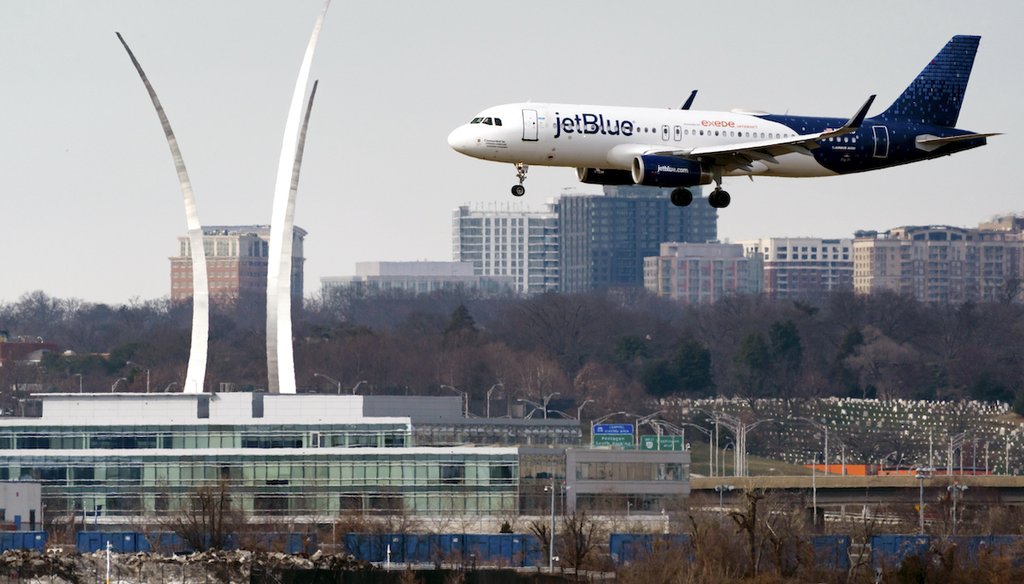



A passenger plane lands at Reagan Washington National Airport in Arlington, Va., across the Potomac River from Washington, Jan. 19, 2022.
• The Federal Aviation Administration’s concern about 5G technology is that it could cause wireless interference with instruments onboard aircraft.
• Current evidence does not support the claim that 5G technology is a health hazard.
A social media post draws a misleading comparison between humans and airplanes to raise concerns about the U.S. deployment of 5G wireless technology.
The Jan. 19 Facebook post says, "If the FAA is worried about what the 5G deployment will do to the planes, what do you think it will do to our bodies?"
The post was flagged as part of Facebook’s efforts to combat false news and misinformation on its News Feed. (Read more about our partnership with Facebook.)
The post implies that the Federal Aviation Administration’s concerns about 5G causing problems for airplanes are also applicable to humans; that is inaccurate. The concern about 5G is that it could cause wireless interference with instruments onboard aircraft operating on nearby frequencies, potentially imperiling safety.
And current evidence does not support the claim that 5G technology is a health hazard.
5G, which stands for the fifth generation of cellular networks, is not brand new; several carriers have been using the networks for a few years. Until now, the 5G networks used either low-band spectrum, with speeds that don’t differ much from 4G, or high-band millimeter wave, which has limited coverage.
Beginning Jan. 19, Verizon and AT&T introduced C-band 5G networks, which operate at a frequency range between 3.7 and 3.98 gigahertz, according to the technology media site CNET. "That frequency falls under what is known as midband spectrum."
Midband spectrum offers faster speeds than 4G and better coverage than high-band millimeter wave, CNET reported. For customers with compatible cell phones, the new network means downloading a movie in seconds or playing graphics-heavy games with no delays.
But the 3.7-to-3.98-gigahertz frequency range for the C-band networks in the U.S. is where the aviation difficulties come into play.
Aircraft use an electronic instrument called radar altimeter to help gauge altitude. It’s important in certain situations, such as when pilots are landing in poor weather conditions. Radar altimeters operate on a spectrum between 4.2 and 4.4 GHz.
"The problem is that wireless signals are not 100% confined to the bands of spectrum they're assigned to," Randall Berry, a professor of electrical engineering at Northwestern University, told NBC News. "The concern here is that signals from the 5G band could leak over into the band that airlines are using and confuse these altimeters."
In European countries where midband spectrum 5G networks have already been rolled out, the networks use a slower range of frequencies, between 3.4 and 3.8 GHz. And some countries have restricted the placement of 5G antennas near airfields, according to CNN.
For now, Verizon and AT&T are temporarily limiting C-band 5G services around some airports while they work with federal agencies to find a longer-term solution.
Regardless of where or how 5G is rolled out, current evidence does not support the claim that the technology is harmful to people’s health.
The radiofrequency waves used by 5G networks "are higher frequency (higher energy) than those used by older generations, (but) they are still forms of non-ionizing radiation, so they still lack the ability to directly damage DNA," according to the American Cancer Society.
Non-ionizing radiation, which includes FM radio waves and microwaves, is not harmful and is different from ionizing forms of radiation, such as X-rays and ultraviolet rays, which can be harmful.
The World Health Organization, which has been investigating the potential health impacts of radio frequency exposure since 1996, concurs: "To date, and after much research performed, no adverse health effect has been causally linked with exposure to wireless technologies."
A Facebook post says, "If the FAA is worried about what the 5G deployment will do to the planes, what do you think it will do to our bodies?"
The post inaccurately implies that the FAA’s concerns about radio interference are also applicable to human health. That’s not the case. The concern about 5G is that it could cause wireless interference with instruments onboard airplanes, potentially imperiling safety.
Current evidence does not support the claim that 5G technology is a health hazard.
We rate this claim False.
American Cancer Society, "Cell Phone Towers," last updated June 1, 2020
CNET, "Verizon and AT&T's C-band 5G upgrade: From airports to rollouts, the latest on what you need to know," Jan. 19, 2022
CNN, "Europe rolled out 5G without hurting aviation. Here's how," Jan. 19, 2022
CNN, "What is C-band 5G? Verizon and AT&T are flipping on the switch in the US," Jan. 19, 2021
Facebook post, Jan. 19, 2022
NBC News, "Why are airlines squaring off against wireless companies over 5G?" Jan 20, 2022
PolitiFact, "No, 5G technology does not cause COVID-19 symptoms," Dec. 21, 2021
Verizon, "What does 5G mean?," Nov. 5, 2019
World Health Organization, "Radiation: 5G mobile networks and health," last updated Feb. 27, 2020
In a world of wild talk and fake news, help us stand up for the facts.
